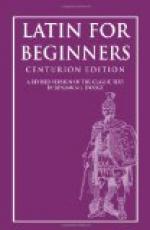ADVERB
diu:\, _for a long time, long_
190. Meanings of the Perfect. The perfect tense has two distinct meanings. The first of these is equivalent to the English present perfect, or perfect with have, and denotes that the action of the verb is complete at the time of speaking; as, I have finished my work. As this denotes completed action at a definite time, it is called the perfect definite\.
The perfect is also used to denote an action that happened sometime in the past; as, I finished my work. As no definite time is specified, this is called the perfect indefinite\. It corresponds to the ordinary use of the English past tense.
a. Note carefully the difference between the following tenses:
I {was finishing } my work (imperfect, Sec. 134)
{used to finish}
I finished my work (perfect indefinite)
I have finished my work (perfect definite)
When telling a story the Latin uses the perfect indefinite to mark the different forward steps of the narrative, and the imperfect to describe situations and circumstances that attend these steps. If the following sentences were Latin, what tenses would be used?
“Last week I went to Boston.
I was trying to find an old friend of
mine, but he was out of the city. Yesterday
I returned home.”
191. Inflection of the Perfect. We learned in Sec. 186 that any perfect is inflected by adding the endings of the perfect to the perfect stem. The inflection in the four regular conjugations is then as follows:
CONJ. I ama:vi: I have loved, I loved or did love CONJ. II monui: I have advised, I advised or did advise CONJ. III re:xi: I have ruled, I ruled or did rule ce:pi: I have taken, I took or did take CONJ. IV audi:vi: I have heard, I heard or did hear
PERFECT STEMS
ama:v- monu- re:x- ce:p-
audi:v-
SINGULAR
1. ama:’vi: mo’nui: re:’xi: ce:’pi: audi:’vi:
2. ama:vis’ti: monuis’ti: re:xis’ti: ce:pis’ti: audi:vis’ti:
3. ama:’vit mo’nuit re:’xit ce:’pit audi:’vit
PLURAL
1. ama:’vimus monu’imus
re:’ximus ce:’pimus audi:’vimus
2. ama:vis’tis monuis’tis
re:xis’tis ce:pis’tis audi:vis’tis
3. ama:ve:’runt monue:’runt
re:xe:’runt ce:pe:’runt audi:ve:’runt
or
or or or
or
ama:ve:’re
monue:’re re:xe:’re ce:pe:’re
audi:ve:’re
1. The first person of the perfect
is always given as the third of the
principal parts. From this we get
the perfect stem. This shows the
absolute necessity of learning the principal
parts thoroughly.




